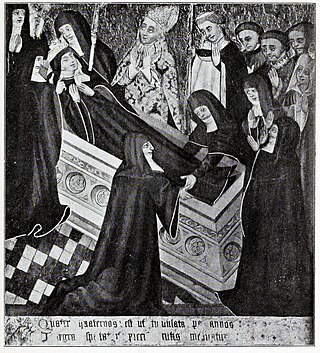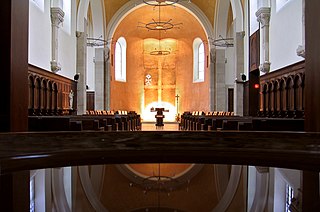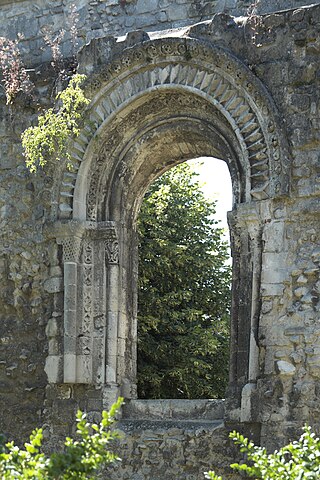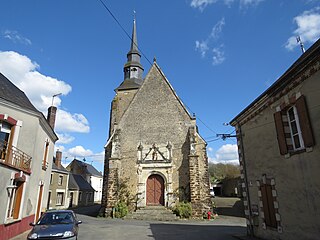Life
Berthild was born into one of the most illustrious families in the territory of Soissons, France, during the reign of Dagobert I. [1]
She entered the nunnery of Jouarre in Brie, not far from Meaux, founded in 630 by Ado, the elder brother of Saint Ouen, who had taken the monastic habit there. Berthild was educated by Saint Thelchildis, the first abbess of Jouarre, who governed that abbey until 660.
When Saint Bathildis, the wife of Clovis II, founded the abbey of Chelles, which Saint Clotildis had first instituted near the Marne, she asked Saint Thelchildis to set up a new community there with the most experienced and virtuous nuns of Jouarre to direct the novices in the monastic order. Berthild was appointed first abbess of Chelles Abbey in 646.
Berthild was known for her devotion to self-denial. She "was ambitious of martyrdom, but as no persecutors were forthcoming, she martyred herself with austerities." [2]
Saint Berthild's reputation drew several foreign princesses to the abbey. Among them was Queen Bathildis. After the death of her husband in 655, she was left regent of the kingdom during the minority of her son Clotaire III, but as soon as he was of age to govern in 665, she retired to Chelles Abbey. Saint Berthild died in 692 after governing the nunnery for forty-six years.

Balthild, also spelled Bathilda, Bauthieult or Baudour, was queen consort of Neustria and Burgundy by marriage to Clovis II, the King of Neustria and Burgundy (639–658), and regent during the minority of her son, Chlothar III. Her hagiography was intended to further her successful candidature for sainthood.

Osgyth was a Mercian noblewoman and prioress, venerated as an English saint since the 8th century, from soon after her death. She is primarily commemorated in the village of St Osyth, in Essex, near Colchester. Alternative spellings of her name include Sythe, Othith and Ositha. Born of a noble family, she became a nun and founded a priory near Chich which was later named after her.
Saint Amatus, also called St. Aimé or Aimé of Sion, was a Benedictine monk.

Seaxburh, also Saint Sexburga of Ely, was a Queen as well as an abbess, and is a saint of the Christian Church. She was married to King Eorcenberht of Kent.
Itta of Metz, O.S.B. was the wife of Pepin of Landen, Mayor of the Palace of the Kingdom of Austrasia. After his death, she founded the Abbey of Nivelles, where she became a Colombanian nun along with her daughter, Gertrude of Nivelles. Both are honored as saints by the Catholic Church.

Saint Waltrude is the patron saint of Mons, Belgium, where she is known in French as Sainte Waudru, and of Herentals, Belgium, where she is known in Dutch as Sint-Waldetrudis or -Waltrudis. Both cities boast a large medieval church that bears her name.

Sadalberga was the daughter of Gundoin, Duke of Alsace and his wife Saretrude. Sadalberga founded the Abbey of St John at Laon. She is the subject of a short hagiography, the Vita Sadalbergae.

Jouarre is a commune in the Seine-et-Marne department in the Île-de-France region in north-central France.

Chelles Abbey was a Frankish monastery founded around 657/660 during the early medieval period. It was intended initially as a monastery for women; then its reputation for great learning grew, and when men wanted to follow the monastic life, a parallel male community was established, creating a double monastery.

Jouarre Abbey is a Benedictine abbey in Jouarre in the département of Seine-et-Marne.
Saint Thecla of Kitzingen was a Benedictine nun and abbess. Born in England, she went to Germany to assist Saint Boniface in his missionary labors.

November 4 - Eastern Orthodox liturgical calendar - November 6
Adalbert I of Ostrevent was a 7th-century Frankish nobleman of the court of King Clovis II of France. He is recognized as a saint, and is commemorated on both 2 February and 2 May.

Saint Thelchildis, was abbess of Jouarre Abbey.

Notre-Dame de Soissons was a nunnery dedicated to the Virgin Mary in Soissons. It was founded during the Merovingian era, between 658 and 666, but the community was dissolved and the building partially demolished during the French Revolution (1789–99).

Aldetrude was a Christian saint and from 684 was abbess of Maubeuge Abbey in the County of Hainault, now in northern France. She is also known as Aldetrude de Maubeuge, Aldetrude of Maubod, Aldetrudis and Adeltrude.

Saint Madelberte of Maubeuge was a 7th-century nun related to the Merovingian dynasty. She became abbess of Maubeuge Abbey in the County of Hainaut, now in northern France near the Belgian border. She died in 705 or 706.

Saint Osmanna was said to be a virgin of Irish royal origin who lived alone in the woods near the mouth of the Loire in France, performed many miracles of healing, and came to be considered a saint. Her story may have little basis in fact. Her feast day is 9 September.

Saint Syra of Troyes was an Irish woman, sister of Saint Fiacre, who became a nun in France and died in Meaux but came to be venerated in Troyes. Her story has been conflated with that of a woman named Syria who died in Troyes in the 4th or 5th century. Her feast day is 8 June.
Saint Æthelflæda of Romsey was an early Abbess of Romsey Abbey in the reign of King Edgar. Her identity is obscure, though in later stories she was said to be the daughter of a tenth-century nobleman. She has been distinguished from Ælflæda, daughter of Edward the Elder, who was herself connected with the founding of the Abbey.














